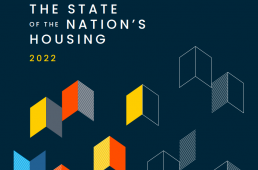
July 8, 2022 | by Michael Wilt
Categories: Affordable Housing, Construction, Homelessness, Homeownership, Rental Housing
Each year, the Joint Center for Housing Studies of Harvard University (JCHS) publishes their State of the Nation's Housing report documenting the pace of housing production, cost of housing, and changing market conditions and household indices.
Released last month, the State of the Nation's Housing 2022 report's main finding is that there should be some relief to high housing costs as rising interest rates are taking "some heat out of the homebuying market," and for renters, a robust pipeline of units under construction are allowing supply to catch up with demand. However, for lower-income households and households of color, the report notes that "the pressure of housing costs is unlikely to relent."
There are six other primary findings in the report summarized below.
- Housing costs continue to soar. Nationwide, home price appreciation hit 20.6 percent in March 2022, eclipsing the previous high of 20.0 percent in August 2021, marking the single largest jump in the past three decades since this metric was first tracked. Moreover, home buyers are increasingly competing against investors for moderately-priced homes as "the investor share of single-family homes sold in the first quarter of 2022 hit 28 percent, well above the 19 percent share a year earlier." Rents continue to rise too, up 12 percent in the first quarter of 2022 from a year earlier.
- New household formations are on the rise. For the past two years, new household formation has increased by about 1.6 million households annually. This exceeded JCHS' projected annual rate of 1.2 million households. The primary contributing factor for this was the increase in millennial households. Low unemployment, increased economic gains pre-pandemic, and a quick economic recovery from the pandemic allowed many millennial households to leap into the housing market.
- Homeownership is trending up, but there are still hurdles for first-time buyers. Between the first quarter of 2020 and the first quarter of 2022, there were 2.2 million new homeowners allowing the homeownership rate to increase to 65.4 percent (up .1%). Younger households are leading the way as buyers under the age of 45 account for 2.7 million new homeowners over the past five years. Households of color make up 55% of the increase in homebuyers over the past two years, but at a 45.3% homeownership rate for Black households and a 49.1% rate for Hispanic households, their homeownership rates remain well below the national average.
For first-time buyers, the increase in interest rates is having a dramatic impact on homeownership. The 2.0 percentage point increase in interest rates between December 2021 and April 2022 "is equivalent to that of a 27 percent jump in home prices." Down payments also remain a persistent hurdle. The average down payment is 7% of the sales price which equals $27,400 for a median-priced home, a significant amount for renters who, on average, have $1,500 in savings.
- Housing construction reaching record highs. There were 1.1 million single-family starts in 2021, the highest amount in the past 13 years. There were 470,000 multifamily starts last year, the highest it has been in 30 years. Many of these homes and apartments are catering to the upper-end of the market, but overall, new units saturating the market should allow some relief to buyers and renters alike as supply catches up to demand.
- Cost burdens are still worrisome, primarily for renters. The percentage of overall cost burdened households (a household that spends more than 30% of income on housing) stands at 30%, and 14% are severely cost burdened (spend more than 50% of income on housing). When looking at renters alone, the numbers are bleaker as 46% of renter households are cost burdened, and 24% are severely cost burdened. Inflation is making matters worse for these households as the skyrocketing cost of food, utilities, and gas equate to an average of $200 more in monthly expenses compared to a year ago.
- The outlook is largely positive. Assuming inflation comes down in a way that doesn't completely slow down the economy, the overall outlook for the housing market is positive. This is primarily due to low unemployment, strong wage growth, and supply chain disruptions becoming less common. The most pressing challenge will remain the affordability of housing, but the report does state that scaling up new innovations in housing construction that reduce costs and land use reforms that encourage density could both help with long-term affordability challenges.
We invite you to check out the interactive maps (located here) to see what's going on in your area in addition to reading the full report. We also invite you to follow the Joint Center for Housing Studies of Harvard University on twitter @Harvard_JCHS to learn about their report and stay up to date on housing trends and issues.
On the House blog posts are meant to provide general information on various housing-related issues, research and programs. We are not liable for any errors or inaccuracies in the information provided by blog sources. Furthermore, this blog is not legal advice and should not be used as a substitute for legal advice from a licensed professional attorney.
